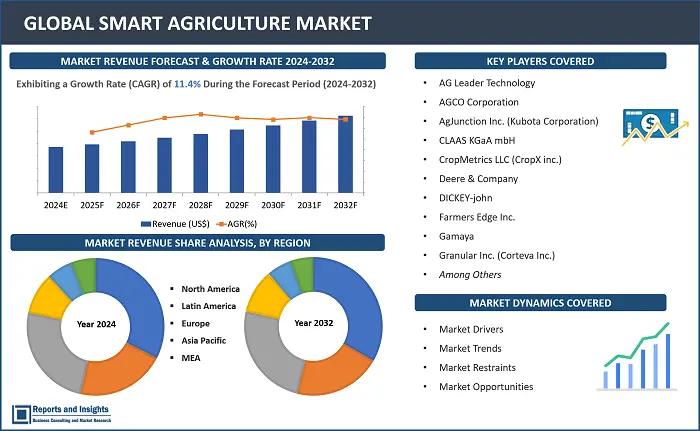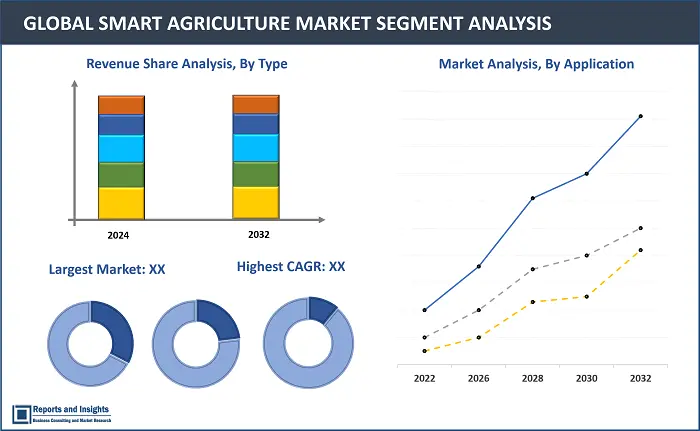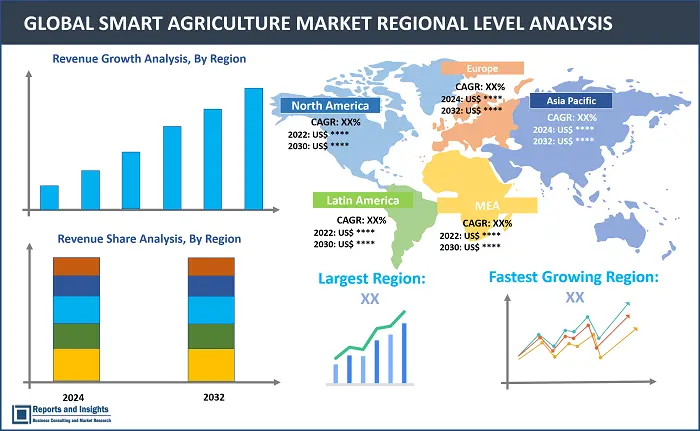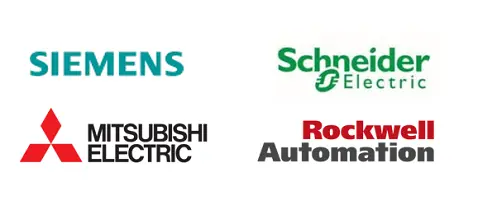Market Overview:
"The smart agriculture market size reached USD 20.6 billion in 2023. Looking forward, Reports and Insights expects the market to reach USD 54.43 billion by 2032, exhibiting a growth rate (CAGR) of 11.4% during 2024-2032."
|
Report Attributes |
Details |
|
Base Year |
2023 |
|
Forecast Years |
2024-2032 |
|
Historical Years |
2021-2023 |
|
Market Growth Rate (2024-2032) |
11.4% |
Smart agriculture, also termed precision agriculture, involves the incorporation of cutting-edge technologies, data analysis, and automation into conventional farming practices. This approach utilizes sensors, drones, GPS technology, and Internet of Things (IoT) devices to gather and analyse real-time data on factors such as soil conditions, weather patterns, crop health, and equipment performance. By leveraging this data, farmers can make well-informed decisions to optimize resource utilization, improve crop yield, minimize environmental impact, and enhance overall efficiency in agricultural processes. The goal of smart agriculture is to transform traditional farming methods by utilizing technology to create a more sustainable, productive, and precise farming ecosystem.
The smart agriculture market is witnessing substantial growth, fueled by the integration of advanced technologies into traditional farming. This market embraces precision farming, data analytics, and the incorporation of IoT devices to optimize agricultural efficiency, enhance crop yields, and improve resource utilization. Essential elements within the smart agriculture market include sensors, drones, GPS technology, automated machinery, and software solutions that facilitate real-time monitoring and data-driven decision-making. The increasing global population, growing demand for food production, and the imperative for sustainable farming practices are driving the widespread adoption of smart agriculture technologies. Consequently, ongoing innovations in AI, machine learning, and connectivity are propelling the evolution of smart agriculture on a global scale.

Smart Agriculture Market Trends and Drivers
The smart agriculture market is experiencing strong growth due to various trends and driving factors. Increased global population and the growing demand for food production have led the agriculture industry to embrace advanced technologies for enhanced efficiency and sustainability. Precision farming, incorporating IoT devices, sensors, and data analytics, is becoming increasingly essential, enabling real-time monitoring and data-driven decision-making in agriculture. The focus on optimizing resources, coupled with the integration of artificial intelligence and machine learning, is improving crop yields while minimizing environmental impact. Moreover, challenges such as climate change, water scarcity, and the necessity for more resilient farming practices are hastening the adoption of smart agriculture solutions. Ongoing advancements in these technologies and a growing recognition of their advantages are shaping the trajectory of smart agriculture, positioning it as a transformative influence in the future of global food production.
Smart Agriculture Market Restraining Factors
Despite the optimistic trajectory of the smart agriculture market, several factors are impeding its widespread adoption. The substantial initial costs associated with acquiring and implementing advanced technologies, including precision farming tools and IoT devices, pose a significant hurdle for smaller-scale farmers. Concerns about data privacy and cybersecurity, given the substantial amount of sensitive agricultural data generated, can undermine trust and slow down adoption. In regions with limited infrastructure, particularly in developing areas, seamless integration of smart agriculture solutions may face obstacles. Additionally, the lack of standardized protocols and interoperability among diverse technologies presents a challenge, hindering the development of a cohesive ecosystem. Addressing these inhibiting factors is essential to foster broader acceptance and sustainable growth of smart agriculture across varied agricultural landscapes.
Smart Agriculture Market Opportunities
The smart agriculture market presents abundant opportunities driven by several pivotal factors. With the world's growing population and an increasing demand for food security, there is a pressing need for inventive agricultural solutions. Opportunities lie in advancing technologies like artificial intelligence, machine learning, and blockchain to further refine precision farming practices. The escalating focus on sustainable agriculture creates openings for the implementation of environmentally friendly solutions that minimize ecological impact. Collaborative efforts among technology providers, agricultural stakeholders, and research institutions hold the potential for ground-breaking innovations. Furthermore, the expansion of smart agriculture in developing regions, where substantial untapped potential exists, offers pathways for market growth and the empowerment of local farmers. As the industry continues its evolution, those who can capitalize on these opportunities are poised to make significant contributions to the transformation and advancement of global agriculture.
Smart Agriculture Market Segmentation

By Agriculture Type
- Precision Farming
- Livestock Monitoring
- Smart Greenhouse
- Others
The smart agriculture market can be categorized based on agriculture type into precision farming, livestock monitoring, smart greenhouse, and other segments. Precision farming utilizes advanced technologies like GPS, sensors, and data analytics to enhance crop management practices, ensuring efficient resource utilization and improved yields. Livestock monitoring employs IoT devices to track and manage the health and well-being of animals, ultimately enhancing overall farm productivity. Smart greenhouse solutions integrate technology to create a controlled environment, optimizing conditions for crop growth. The "Others" category encompasses various emerging technologies and applications contributing to the evolution of smart agriculture, such as drone technology for crop monitoring and autonomous vehicles for field operations. This segmentation highlights the diverse applications of smart agriculture, illustrating how technology is tailored to specific aspects of farming to boost efficiency and sustainability.
By Offering
- Hardware
- Software
- Service
The smart agriculture market is classified by its offerings into hardware, software, and services. Hardware includes the physical elements like sensors, drones, and automated machinery that constitute the technological infrastructure of smart agriculture systems. Software involves the creation of applications, platforms, and data analytics tools to interpret and manage the extensive data collected from agricultural operations, enabling well-informed decision-making. Services encompass various support options such as consulting, maintenance, and training, assisting farmers in the implementation and optimization of smart agriculture technologies. This segmentation underscores the integrated nature of smart agriculture solutions, where the collaboration between hardware, software, and services forms a comprehensive ecosystem geared towards improving agricultural efficiency, sustainability, and productivity.
By Farm Size
- Small
- Medium
- Large
The smart agriculture market can be classified based on farm size into small, medium, and large operations. Small farms, with limited acreage and resources, benefit from affordable and straightforward smart agriculture technologies, often emphasizing basic precision farming tools. Medium-sized farms, featuring a moderate scale and resources, have access to a broader range of smart agriculture solutions, including advanced precision farming technologies and data analytics tools. Large farms, characterized by extensive acreage and substantial resources, utilize sophisticated technologies such as automated machinery, drones, and advanced data analytics for comprehensive farm management. This segmentation acknowledges the diverse needs and resources of farms with varying sizes, highlighting the flexibility of smart agriculture technologies in addressing the specific requirements of small, medium, and large-scale agricultural operations.
By Region

North America
- United States
- Canada
Europe
- Germany
- United Kingdom
- France
- Italy
- Spain
- Russia
- Poland
- Benelux
- Nordic
- Rest of Europe
Asia Pacific
- China
- Japan
- India
- South Korea
- ASEAN
- Australia & New Zealand
- Rest of Asia Pacific
Latin America
- Brazil
- Mexico
- Argentina
Middle East & Africa
- Saudi Arabia
- South Africa
- United Arab Emirates
- Israel
- Rest of MEA
The smart agriculture market is divided by region, including North America, Europe, Asia Pacific, Latin America, and the Middle East and Africa. In North America, the robust agricultural sector and a high affinity for advanced technologies drive the adoption of smart agriculture solutions. Europe demonstrates a growing interest in precision farming and sustainable agricultural practices, fostering the integration of smart agriculture technologies. The Asia Pacific region, with its expansive agricultural landscape, is experiencing an uptick in the adoption of these technologies to meet the increasing demand for food production. Latin America is embracing smart agriculture to improve productivity and resource efficiency. In the Middle East and Africa, there is a focus on utilizing technology to overcome challenges related to water scarcity and climatic conditions. The unique agricultural landscapes and challenges in each region contribute to varying levels of adoption of smart agriculture, showcasing the versatility of these technologies in diverse global agricultural settings.
Leading Smart Agriculture Manufacturers & Competitive Landscape:
The smart agriculture market is highly competitive, with several key players vying for market share and actively engaging in strategic initiatives. These companies focus on product innovation, technological advancements, and expanding their product portfolios to gain a competitive edge. These companies are continuously investing in research and development activities to enhance their product offerings and cater to the evolving needs of customers in terms of efficiency, performance, and sustainability.
These companies include:
- AG Leader Technology
- AGCO Corporation
- AgJunction Inc. (Kubota Corporation)
- CLAAS KGaA mbH
- CropMetrics LLC (CropX inc.)
- Deere & Company
- DICKEY-john
- Farmers Edge Inc.
- Gamaya
- Granular Inc. (Corteva Inc.)
- Raven Industries Inc. (CNH Industrial N.V.)
- Trimble Inc.
Recent Development:
- April 2023: Bosch, BASF Smart Farming, and AGCO Corporation have jointly announced today their collaboration to integrate and commercialize Smart Spraying technology on Fendt Rogatory sprayers. Additionally, the three companies will work together to develop new features for the technology.
Market Research Scope
|
Report Metric |
Report Details |
|
Market size available for the years |
2021-2023 |
|
Base Year |
2023 |
|
Forecast Period |
2024-2032 |
|
Compound Annual Growth Rate (CAGR) |
11.4% |
|
Segment covered |
Agriculture type, offering, farm size and regions. |
|
Regions Covered |
North America: The U.S. & Canada Latin America: Brazil, Mexico, Argentina, & Rest of Latin America Asia Pacific: China, India, Japan, Australia & New Zealand, ASEAN, & Rest of Asia Pacific Europe: Germany, The U.K., France, Spain, Italy, Russia, Poland, BENELUX, NORDIC, & Rest of Europe The Middle East & Africa: Saudi Arabia, United Arab Emirates, South Africa, Egypt, Israel, and Rest of MEA |
|
Fastest Growing Country in Europe |
Germany |
|
Largest Market |
North America |
|
Key Players |
AG Leader Technology, AGCO Corporation, AgJunction Inc. (Kubota Corporation), CLAAS KGaA mbH, CropMetrics LLC (CropX inc.), Deere & Company, DICKEY-john, Farmers Edge Inc., Gamaya, Granular Inc. (Corteva Inc.), Raven Industries Inc. (CNH Industrial N.V.) and Trimble Inc. |
Frequently Asked Question
What is the market size of smart agriculture market in the year 2023?
The smart agriculture market size reached USD 20.6 billion in 2023.
What are some key factors driving revenue growth of the smart agriculture market?
Some key factors driving smart agriculture market revenue growth include technological advancements, precision farming adoption, demand for sustainable agriculture, and population growth and food security.
What are some major challenges faced by companies in the smart agriculture market?
Companies face challenges such as high initial investment, data privacy and security concerns, and limited connectivity in rural areas.
How is the competitive landscape in the global smart agriculture market?
The market is competitive, with key players focusing on technological advancements, product innovation, and strategic partnerships. Factors such as product quality, reliability, after-sales services, and customization capabilities play a significant role in determining competitiveness.
Which region has the biggest market share in smart agriculture market?
North America has the biggest market share in smart agriculture market.
At what CAGR will the smart agriculture market expand?
The market is anticipated to rise at 11.4% CAGR.
How is the smart agriculture market segmented?
The market is segmented based on agriculture type, offering, farm size and regions.
What are the key players in smart agriculture market?
The key players in smart agriculture market include AG Leader Technology, AGCO Corporation, AgJunction Inc. (Kubota Corporation), CLAAS KGaA mbH, CropMetrics LLC (CropX inc.), Deere & Company, DICKEY-john, Farmers Edge Inc., Gamaya, Granular Inc. (Corteva Inc.), Raven Industries Inc. (CNH Industrial N.V.) and Trimble Inc.

